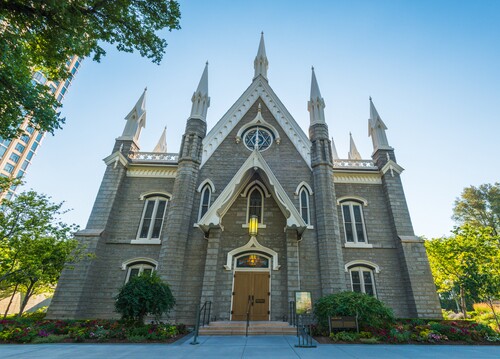Originally finished in 1882 and renovated in the early 1980s, the Salt Lake Assembly Hall has been around for almost 140 years. It has hosted thousands of concerts, lectures, and Church meetings, and its architecture, acoustics, and historical significance have inspired the interest of both members and nonmembers alike. Here are seven fascinating facts you might not know about this historical building.
1. Brigham Young suggested the building of the Assembly Hall 18 days before he died.
Before the Assembly Hall was built, an old adobe tabernacle occupied the southwest corner of the temple block. But on August 11, 1877, in a priesthood meeting for the Salt Lake Stake, President Brigham Young suggested that the old tabernacle be replaced by a new structure for the stake to meet in.
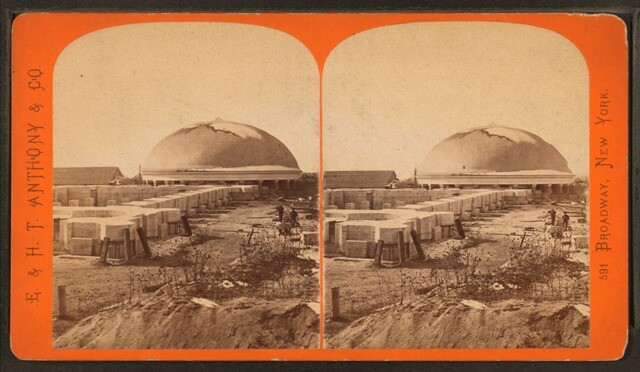
The old tabernacle. Image from of wikimedia.org.
Though President Young passed away just over two weeks later, leaders from the stake immediately began work to raze the old tabernacle and begin construction of the new hall. It was dedicated by President Joseph F. Smith almost five years later.
2. General conference was sometimes held in the Assembly Hall.
Before the Conference Center was completed in the year 2000, general conference was typically held in the Tabernacle presently on Temple Square. But if the congregation didn’t dress warmly, it was uncomfortably cold! On chilly spring days or cold autumn mornings, the Assembly Hall’s smaller size and steaming heat system made it a more comfortable place to be held.
The Deseret News reported in November 1882 that “President [John] Taylor said as the weather continued cold and we were unable to warm the Tabernacle, conference would meet this afternoon in the Assembly Hall at 2 o’clock P.M. If the weather was warmer on Saturday, we would meet in the Tabernacle, when all should come well clothed” (Deseret News, 6 October 1882).
►You’ll also like: 25 Things You Didn't Know About the Tabernacle
Today, the Assembly Hall is still used as overflow for general conference and other meetings that are broadcasted on Temple Square.
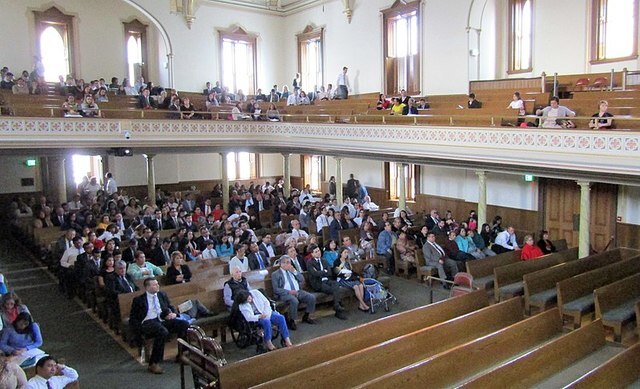
Church members watching general conference in Spanish in the Assembly Hall, March 2018. Photo from of wikimedia.org.
3. The Assembly Hall was built out of the same stone as the Salt Lake Temple.
Though the Assembly Hall’s bricks appear rougher than the stone used to build the Salt Lake Temple, it was quarried from the same location as the temple granite. As quarrymen carved large, smooth blocks of stone for the temple, the smaller pieces they carved away were used as bricks to build the Assembly Hall (see Don F. Calvin, “Quarrying the Temple Granite,” Ensign, Oct. 1975).
Although the interior underwent significant renovations in the 1980s, most of the exterior remains the same, from the original stone down to the six-pointed Stars of David on the four sides of the building.
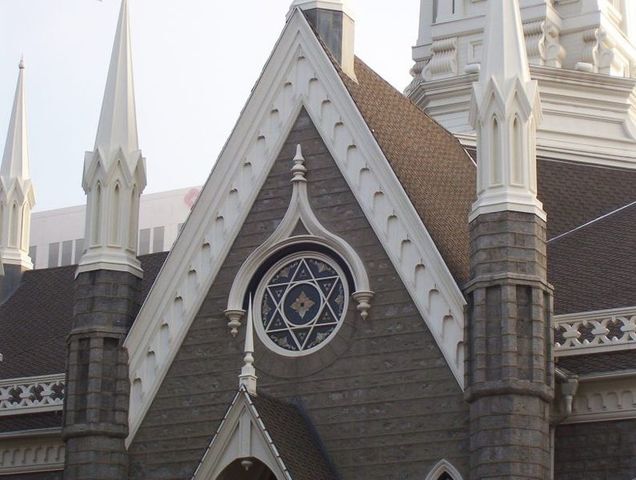
Photo from wikimedia.org.
4. The “bepinnacled tabernacle” has 24 spires.
The Assembly Hall, which was once referred to by the Salt Lake Telegram as the “bepinnacled tabernacle,” has 24 white spires pointing heavenward (JoAnn Jolly, “Century-Old Assembly Hall is Renovated,” Ensign, Feb. 1983). When the hall was renovated, these pinnacles were replaced with white fiberglass replicas of the originals.
Though the current spires are only replicas, architects made significant efforts to keep them as identical to the originals as possible. On the southwest side of the building, one of the spires is flat because it represents what used to be a chimney flue. While the chimney no longer exists, the flat spire accurately shows what the spire looked like when it was originally built.
►You’ll also like: 40 Things You Didn't Know About Temple Square

The "bepinnacled" tabernacle. Photo from wikimedia.org.
5. The ceiling once had murals depicting the temple, prophets, and other scenes of the Restoration.
The Assembly Hall originally displayed paintings related to Church history on its ceiling. These paintings included Church leaders, temples, and a depiction of Joseph Smith receiving the plates from Moroni.
In the early 1900s, the ceiling was painted over and redesigned to have gold-painted woodwork and white sego lilies, which are now recognized as Utah’s state flower. These flowers saved the lives of the early Saints after Native Americans taught them to use them for food (Geraldine T. Fielding, “Life-Saving Lily,” Friend, July 1997). The gold and white sego lily design is still displayed on the ceiling of the Assembly Hall today.
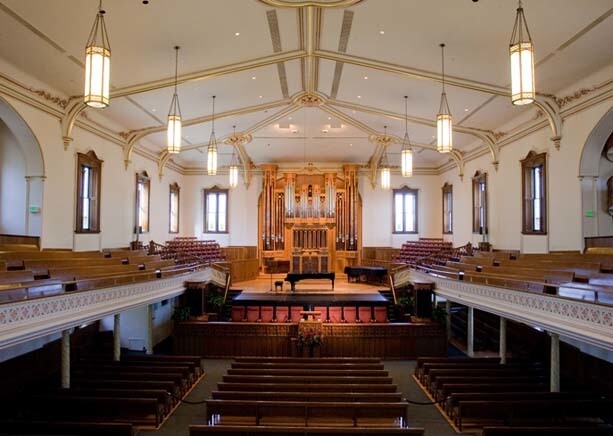
Photo of the Assembly Hall's current ceiling design, from lds.org.
►Click here to see comparisons of the Assembly Hall's ceiling then and now
6. To preserve both the historical appearance and impressive acoustics, speakers are hidden under the benches.
When the Assembly Hall was renovated in the 1980s, architects took great care to both preserve the historical appearance and natural acoustics of the building while still updating the technology to transmit sound for both the spoken word and musical performances.
Because of this, installing the Assembly Hall’s new speaker system proved to be an interesting challenge. To avoid putting clusters of speakers in the ceiling or on the walls, the initial idea was to place the speakers behind the benches. However, the placement of the pews was very tight, leaving insufficient room to mount the speakers while still maintaining the original seating layout. Instead, they developed a unique solution: they placed the speakers under the benches, allowing sound to be easily heard while still keeping the technology hidden from view.
►You’ll also like: 30 Things You Didn't Know About the Conference Center
7. The Assembly Hall’s organ has more than 3,000 pipes—each of which have been individually “voiced.”
Little is known about the Assembly Hall’s first organ, but according to a newspaper article from 1878, parts of the organ from the old adobe tabernacle were used to build the organ in the Assembly Hall. It was replaced in 1913 and transformed into an electric organ 10 years later (see “Assembly Hall Organ”).
For the celebration of the Church’s sesquicentennial year and the Assembly Hall’s centennial year in 1980, funds were raised for a new organ. Robert L. Sipe was selected to build the organ because of his meticulous care of “voicing,” which refers to the adjustment of each individual pipe to sing at the desired quality.

The Assembly Hall pipe organ. Photo from wikimedia.org.
In addition to having a beautiful sound, the organ is decorated with hand-carved symbols honoring early Latter-day Saint culture, including beehives, sheaves of wheat, and more sego lilies.

